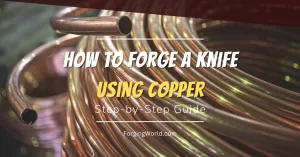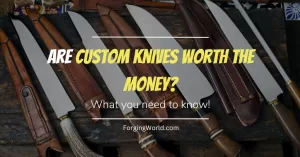Since the beginning of the decade, the interest in knifemaking rises exponentially. In addition, interest in propane forges is growing in parallel, since they are more convenient for knifemaking purposes. In this article, I will answer one of the common questions among beginners, which is:
How big of a forge do you need for knifemaking? The forge for knifemaking should be at least 10-12 inches long for small knives and 20 inches for long knives/swords. Essentially, you want the forge large enough so you are not sticking your knife right into the bright blue cone of the flame which causes scaling and decarburization. The minimum dimension for a square propane forge is 4×6 whereas the minimum diameter for the round shape is 6 inches.
In the end, it all comes to the intended use and type of project you are planning to do. Except for size, we will also talk about the number of burners, their types, ideal forge dimension, and finally the benefits of using propane for knifemaking.
Let’s dive in.
Ideal Propane Forge Dimensions for Knifemaking
As with anything else, the ideal size of the propane forge primarily depends on the size of the blades you are planning to make. For instance, someone who makes swords requires a much longer propane forge than someone who wants to produce small blades. No size fits all purposes.
Ok, so the first thing you want to decide on which blades you plan to make now and also in the near future. To make things more precise, we prepared for you three possible options, including :
- Short blades
- Long blades
- Making pattern-welded steel
Ideal Dimensions for Short Blades
Small blades are generally considered below 16 inches, but keep in mind that is some estimate. Usually, when we are talking about small blades, we are talking about blades that are somewhere at 6-8 inches long.
So, for producing small blades I would recommend having at least 12x4x6 inches forge. Anything longer than that would also be fine, just not too long. Otherwise, you will spend a lot of unnecessary fuel and heat.
Recommended forge: Hell’s Forge Portable Propane Forge Single Burner Knife (affiliate link)
Ideal dimension for Long Blades/Swords
On the opposite, if you want to make long knives or even swords, you need a longer forge. When I say long blades, what I am actually referring to are all blades in the 6-18 inch range. Swords are generally long somewhere between 18 and 31 inches, where 28 inches is the average length.
So, for making long knives I would suggest buying a propane forge at least 18 inches long. For sword making, the ideal length would be somewhere between 20 and 24 inches. Anything smaller than that would be too small to place such a long blade. In terms of dimension, somewhere around 5 inches in diameter would be ideal.
Recommended forge: Portable Propane Triple Burner Knife (affiliate link)
Ideal Dimensions for Making Pattern-Welded Steel
Another common use of propane forge is for making Damascus or pattern-welded steel. However, in order to do that, your forge has to reach forge-welding temperatures that are extremely high (above 2000°F). If the forge cant does that, it cant be used for this purpose but only for forging.
Typically, you want a forge with a small interior volume for producing Damascus or pattern-welded steel. That way the forge can heat the billet to forge-welding temperature. So, I would recommend having an 8-10 inches long forge. The dimension could be something like 4×6 or even less, 4×4 inches.
Recommended forge: Hell’s Forge Portable Propane Forge Single Burner Knife (affiliate link)
How Many Burners Are Necessary for Knifemaking?
The number of burners a propane forge should have is often a hot topic in the knifemaking community. This depends on various factors such as the experience level, the size of the blade, and the internal volume of the forge. For example, a regular hobbyist doesn’t need the same forge as some professional bladesmith may require. The same principle applies to the number of burners.
The general rule of thumb is to have one 3/4″ burner per 300-350 cu/in volume. The larger the interior volume of the forge, the more burners it requires. For most hobbyists, a single burner will be sufficient since they typically use a smaller forge. On the other side, a professional bladesmith will require somewhere between 2 and 4 burners.
A long forge will have a much more even temperature with evenly spaced burners so long as their output is in line with the volume of the chamber. Another important factor is production work. Namely, a hobbyist is less likely to do production work, which means that one small forge with a single burner will do the trick.
Contrarily, a professional bladesmith does some production work, so the large forge with several burners allows him to heat the several blades at the same time. Note that as the number of burners increase, the price does the same. If you have a small forge that is designed for a single burner, don’t try to experiment with adding another one. It is designed that way for a reason.
Keep in mind that the burner should be compatible with your propane tank which may be several different sizes. For example, hobbyists typically use a 20-pound tank whereas professionals use a 100-pound tank. You have to make sure that your burner connects correctly to the propane tank you are using. While it is possible to modify your burner to different tank size, I don’t recommend that since it would be a headache and it would also require extra labor.
What Is the Best Burner for a Propane Forge?
Propane burners are the crucial product you will most probably keep for a long time, so buying something high-quality is recommended. You don’t want to replace your burner every couple of months. If you are making knives occasionally as a hobby, you might get away with some burner for more casual use. On the other side, an advanced bladesmith must have a high-quality burner. I should also mention here that the type of burner greatly impacts the design of the propane forge.
There are two main types of propane burners, including power burners and venturi burners. Both have their own advantages and disadvantages so let’s examine them.
Power Burners
Power burners also called a forced-air burner don’t rely on the chimney and gas action to pull air into the burner. Instead, a mechanical blower is used to force the air into the burner and mix it with larger amounts of propane. Usually, they are better than Venturi burners in terms of large demands low-pressure propane kilns.
Another advantage of power burners is that they are not affected by the weather. Power burners are considered more efficient because all primary air is forced and mixed by the blower. Power burners are quite easy to adjust the heat as well as the fueled air mixture.
The disadvantage of power burners is that they require electricity, which can be a problem sometimes. If you somehow run out of power, it will continue to pump gas into the forge which can be very dangerous. Luckily this can be solved with proper safety equipment and installation. Another downside is that power burners are louder, mainly due to the use of a blower. Note that these burners are designed to only work on low pressure for propane or natural gas.
Venturi Burners
On the other side, venture burners don’t require any power source to operate. Since they don’t use blowers, they are much quieter under low-pressure. These burners operate by the Venturi principle, they force the gas down the center of the burner tube. Venturi burners usually produce different BTU outputs with pressure variation. Keep in mind that higher pressure may reduce efficiency, but provides greater flexibility than the high output of power burners.
So, if you have any unfriendly neighbors that may complain about your work, I would suggest using Venturi burners since they are much quieter.
I would like to add here is that you should look for in which country the burner was manufactured. Typically, products made in the US or other Western countries are often of higher quality than those made in Pakistan, China, or India.
Why Propane Instead of Coal?
Maybe you are wondering why this article is only about propane forge, without any mention of coal or charcoal forge. In this case, this is what this paragraph is all about. Namely, propane forge is generally recommended for knifemaking because of its simplicity, availability, clean-burning, and production work. This is especially the case for beginner knifemakers. For someone who is just getting started in knife making, there are plenty of things he/she must learn.
Learning about tools, steel properties, the process of heat treatment requires a lot of time and effort. If that same person plans on forging by using the coal forge, he must learn proper fire management, which also takes a considerable amount of time. This is why propane forge is considered the best forge-type for knife making.


